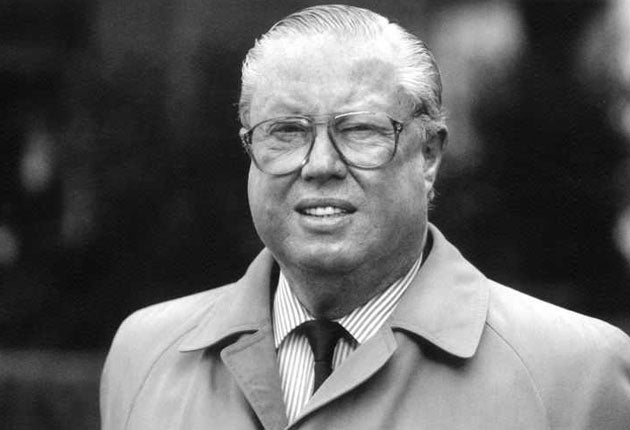John Shepherd-Barron: Inventor of the hole-in-the-wall cash dispenser

John Shepherd-Barron's invention of the automatic cash dispenser – now ubiquitous, but in the 1960s a mysterious contrivance – owed something to his technological grasp, his business sense and his ingenuity. It also owed something to his annoyance with a bank branch when he turned up at 12.31 on a Saturday to find to his irritation that it had closed one minute earlier, which meant he could not cash a cheque.
Later, in his bath, he pondered on the inconvenience. "I remember being infuriated that I could not always get access to my money when I needed it," he recalled, "especially over weekends when banks were closed. I started thinking of a way of getting money around the clock."
Others were thinking along the same lines, and the notion was not new, but Shepherd-Barron's entrepreneurial skills pushed the idea through so that today the number of automatic teller machines (ATMs) is approaching two million worldwide. In Britain alone transactions take place at a rate of a million an hour, the machines having helped transform the habits of millions since they made their appearance in the 1960s.
Shepherd-Barron, who was always something of an ideas man, had successfully imported from the US to Britain the idea of transporting cash in armoured trucks. His technique was first to define the desired end product and then work backwards. "Think out a new idea," he explained. "Work out what you are trying to achieve, including the specs of the product, and then work backwards - never the other way around."
The model he settled on in his mind for the cash machine was that of a chocolate vending machine: "I hit upon the idea of a chocolate bar dispenser, but replacing chocolate with cash," he remembered.
All this fitted neatly with his existing business, since he was already engaged both in printing currency and transporting it around in armoured vans. He explained: "I had been heavily involved in printing money and then moving money. The next step that seemed to follow was dispensing money automatically, to complete the process."
Early models operated on the principle that a special cheque would be inserted in a machine which would then pay out. Shepherd-Barron envisaged a six-digit PIN number but, on the advice of his wife, who said most people could not remember so many numbers, this was reduced to four. Things took off when he persuaded a senior executive of Barclays Bank to listen to his pitch. According to Shepherd-Barron, "I asked him for 90 seconds of his time to share the new idea I had. His reply came after 85 seconds. He said, 'If you can make this device you are speaking about, I will buy it right now.'"
Barclays moved fast, despatching one of its executives to meet him within days. He arrived in the bank's Rolls Royce, which Shepherd-Barron had trouble fitting into his small company's limited parking spaces. A deal was quickly done, with the first cash dispenser going into operation at Enfield in north London in June 1967.
A Barclays executive who was supposed to make the first ceremonial withdrawal had trouble mastering the PIN system so, for the benefit of the watching media, the transaction had be faked. Years later Shepherd-Barron admitted: "We finally bogused it from behind."
When attempts were made to export the "robot cashiers" to the US he found it it was regarded as "a wacky European idea that wouldn't sell in America." But then a Pennsylvania Bank placed an order for six machines, and the idea rapidly spread worldwide. Today ATM locations include McMurdo station in Antarctica. Shepherd- Barron once related: "In northern Thailand I saw a man get off his ox cart, go and get money out of the wall and then get back on his cart. It really brought home to me that I had come up with a worldwide idea."
On legal advice the device was not patented, the lawyers advising that applying for a patent would have involved disclosing the coding system, thus exposing it to criminal penetration. The machines have a high level of security but it is not perfect and they have been targeted in many criminal ways. In Ireland, for example, a number of gangs regularly stage smash-and-grab raids, using the unsubtle but often effective method of using industrial diggers to rip entire machines out of the wall.
John Adrian Shepherd-Barron was born in Shillong in the Indian state of Assam, now Meghalaya, in 1925. His father was a civil engineer while his mother, the tennis player Dorothy Champion, was a Wimbledon ladies doubles champion. He served as an airborne officer in the Second World War before taking a degree at Trinity College, Cambridge and then going into business, joining the De La Rue Instruments banknote-printing company in 1950. His idea of introducing American-style armoured trucks to Britain was a major success, and he was based in America for some years.
Several years ago he received an OBE for services to banking. By this stage he had retired to Scotland, where he dabbled in various schemes aimed at local job creation. These were not notably successful. A snail farming project and a fish farm both ran into problems, the latter when voracious seals preyed on his salmon.
Deploying his talent for invention, he came up with a device which emitted the sound of killer whales to drive the seals away. The seals were however undeterred. He said ruefully of them: "They're clever scoundrels – it's only ended up attracting them more."
John Shepherd-Barron, entrepreneur and inventor: born Shillong, (Assam) Meghalaya, India 23 June 1925; married 1953 Caroline Murray (three sons); OBE 2005; died 15 May 2010.
Join our commenting forum
Join thought-provoking conversations, follow other Independent readers and see their replies
Comments